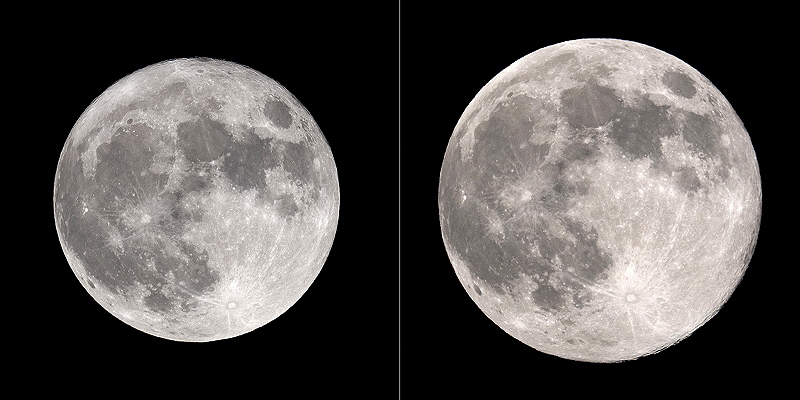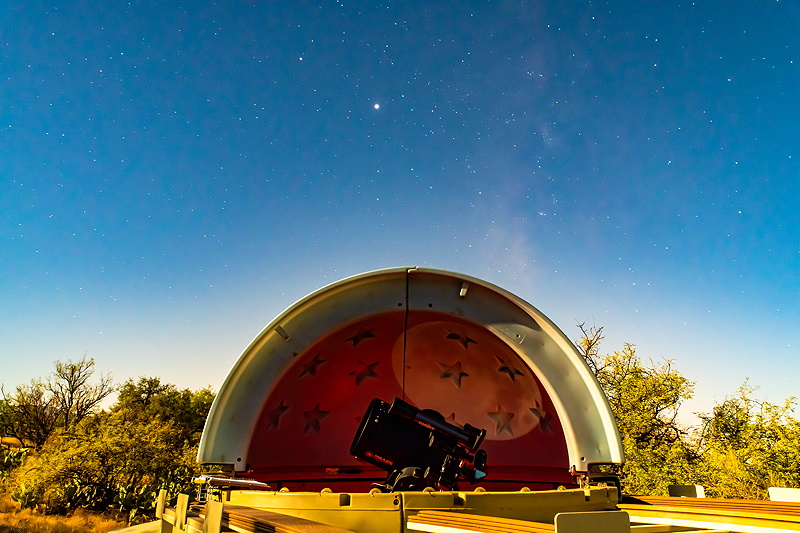Apogee vs Perigee Full Moon,
Moon on Dome
Posted: 2 October 2020
|
Open: Thursday, 1 October 2020, 1911 MST Temperature: 82°F |
Session: 1528 Conditions: Clear |
Equipment:
12" f/8 LX600 w/StarLock
2" 24mm UWA eyepiece
2" 14mm 100° eyepiece
Camera:
D850 DSLR
I was late opening the observatory this night as I wanted to watch the premiere of the "Herb Alpert Is" documentary. Herb Alpert and the Tijuana Brass were (and still are) my favorite band. Herb was (and still is) an amazing trumpet player. As a trumpet player myself beginning back in 1960 I have always enjoyed his music.
1917 MST: LX600 ON, StarLock OFF, High Precision OFF.
The eastern sky was brightening from the rising Full Moon.
Viewed Jupiter and four moons, 102X and 174X. Viewed Saturn and four moons, 174X.
1922 MST: the Full Moon began rising over the hill to the east.
1928 MST: viewed the Moon through a tree, 174X. The entire disk was visible in the Explore Scientific 2" 14mm 100° eyepiece field-of-view. A very slight terminator was visible.
I then relaxed on the observatory patio bench while waiting for the Moon to rise higher.
1939 MST: Mars rose over the hill to the east.
I then began preparing to photograph the Moon using the D850 DSLR. The Moon was near apogee (its furthest from the Earth). This cropped photo was taken with the D850 DSLR (f/11, 1/640sec, ISO 200, FL 600mm).

This is a side-by-side comparison of tonight's Apogee Moon (29.5' angular diameter) on the left to a Perigee Moon (33.6') on the right taken on 7 April 2020 with the same set up and at the same image scale. Along with the size difference, the effects of libration are also evident.

Click or tap on image for larger version
2000 MST: relaxed on the bench while waiting for the Moon to rise above a tree.
2014 MST: back inside the observatory and began setting up to photograph the Full Moon projected onto the observatory dome using the 14mm eyepiece.
2025 MST: took this "Moon on Dome" photo using the D850 DSLR (f/6.3, 20 seconds, ISO 4000, FL 31mm). The planets Saturn and Jupiter and the Milky Way are visible in the bright moonlit sky.

Mouseover or tap on image to show labels
2032 MST: viewed the Full Moon, 174X.
Then viewed Mars, low in the eastern sky, 174X and 102X.
2035 MST: LX600 OFF.
|
Close: Thursday, 1 October 2020, 2046 MST Temperature: 75°F |
Session Length: 1h 35m Conditions: Clear |
Comments are welcome using Email. Twitter users can use the button below to tweet this report to their followers. Thanks.
Cassiopeia Observatory Home Page
Copyright ©2020 Michael L. Weasner / mweasner@me.com
URL = http://www.weasner.com/co/Reports/2020/10/02/index.html
